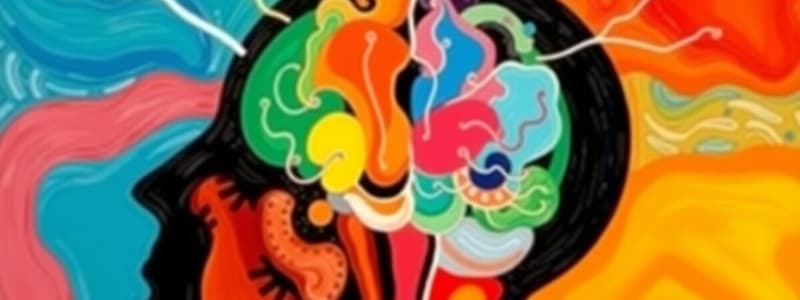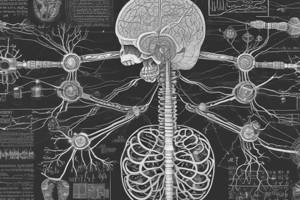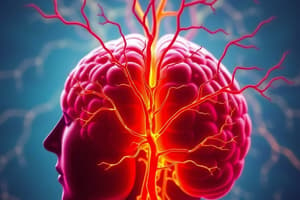Podcast
Questions and Answers
What is the primary function of the sympathetic autonomic nervous system?
What is the primary function of the sympathetic autonomic nervous system?
- To enhance sensory perception under stress.
- To regulate digestion and metabolic processes.
- To maintain a state of rest and relaxation.
- To stimulate the body's fight-or-flight response. (correct)
What do glial cells do in the nervous system?
What do glial cells do in the nervous system?
- Enhance and modify the activity of neurons in various ways. (correct)
- Merge with neurons to form a single cohesive unit.
- Serve as the primary conduits for neurotransmitter release.
- Directly transmit electrical impulses between neurons.
What technique did Santiago Ramón y Cajal use to distinguish nerve cells?
What technique did Santiago Ramón y Cajal use to distinguish nerve cells?
- Staining with silver salts using Golgi’s method. (correct)
- Microscopic dissection and direct observation.
- Chemical labeling with fluorescent dyes.
- Electrical stimulation and recording.
Which of the following statements is true regarding neurons?
Which of the following statements is true regarding neurons?
What overarching concept does the old idea of merging neurons relate to?
What overarching concept does the old idea of merging neurons relate to?
Which part of the central nervous system is primarily involved in the sympathetic autonomic nervous system?
Which part of the central nervous system is primarily involved in the sympathetic autonomic nervous system?
How do neurons convey information to other cells?
How do neurons convey information to other cells?
What aspect of Cajal's research remains significant in neuroscience today?
What aspect of Cajal's research remains significant in neuroscience today?
What is a key characteristic of neurons in terms of their ability to divide?
What is a key characteristic of neurons in terms of their ability to divide?
What determines the function of a neuron?
What determines the function of a neuron?
What is the primary function of dendrites in a neuron?
What is the primary function of dendrites in a neuron?
What is true about the lifespan of neurons in the cerebral cortex?
What is true about the lifespan of neurons in the cerebral cortex?
What role do mitochondria play in nerve cells?
What role do mitochondria play in nerve cells?
Which part of the neuron connects the soma to the axon?
Which part of the neuron connects the soma to the axon?
How do neurons primarily communicate electrochemically?
How do neurons primarily communicate electrochemically?
Neurons in the mature individual are unique because they typically do not undergo what process?
Neurons in the mature individual are unique because they typically do not undergo what process?
What characterizes the axon in a neuron?
What characterizes the axon in a neuron?
Which statement about glial cells is accurate?
Which statement about glial cells is accurate?
What impact do overactive mitochondria have on an individual?
What impact do overactive mitochondria have on an individual?
Which of the following structures is responsible for metabolic activities within the neuron?
Which of the following structures is responsible for metabolic activities within the neuron?
What is a common characteristic of most animal cells, including neurons?
What is a common characteristic of most animal cells, including neurons?
What are dendritic spines and what is their function in neurons?
What are dendritic spines and what is their function in neurons?
What is the role of synaptic receptors located on dendrites?
What is the role of synaptic receptors located on dendrites?
Which characteristic is NOT associated with mature neurons?
Which characteristic is NOT associated with mature neurons?
Flashcards
Sympathetic Nervous System
Sympathetic Nervous System
Part of the autonomic nervous system, located near the spinal cord's thoracic and lumbar regions, stimulating the 'fight-or-flight' response.
Fight-or-Flight Response
Fight-or-Flight Response
Physiological reactions preparing the body for immediate action or escape in response to perceived danger.
Neuron
Neuron
Specialized cell in the nervous system that receives and transmits information.
Glia
Glia
Signup and view all the flashcards
Santiago Ramón y Cajal
Santiago Ramón y Cajal
Signup and view all the flashcards
Neuron Separation
Neuron Separation
Signup and view all the flashcards
Golgi's Method
Golgi's Method
Signup and view all the flashcards
Separate Neurons
Separate Neurons
Signup and view all the flashcards
Neuron lifespan
Neuron lifespan
Signup and view all the flashcards
Neuron variability
Neuron variability
Signup and view all the flashcards
Neuron irreplaceability
Neuron irreplaceability
Signup and view all the flashcards
Neuron energy needs
Neuron energy needs
Signup and view all the flashcards
Neuron structure similarity
Neuron structure similarity
Signup and view all the flashcards
Mitochondrial function
Mitochondrial function
Signup and view all the flashcards
Mitochondrial impact on health
Mitochondrial impact on health
Signup and view all the flashcards
Neuron function
Neuron function
Signup and view all the flashcards
Neuron parts
Neuron parts
Signup and view all the flashcards
Dendrites
Dendrites
Signup and view all the flashcards
Axon
Axon
Signup and view all the flashcards
Soma/Cell Body
Soma/Cell Body
Signup and view all the flashcards
Axon Hillock
Axon Hillock
Signup and view all the flashcards
Dendritic Spines
Dendritic Spines
Signup and view all the flashcards
Synaptic Receptors
Synaptic Receptors
Signup and view all the flashcards
Study Notes
Introduction to the Nervous System
- The nervous system, along with the endocrine system, controls the body's functions.
- The nervous system is made up of specialized cells called neurons. Neurons receive sensory stimuli and conduct impulses to effector organs (muscles or glands).
Consciousness and Death
- Death and consciousness are highly debated topics.
- Some believe consciousness is a direct result of brain activity. Others posit that external forces (e.g., the universe, God) and internal elements (e.g., spirit, life-force) contribute to this state.
- Consciousness is defined as a state of awareness, including one's surroundings and perceptions.
The Importance of the Central Nervous System
- Studying the brain requires understanding its structure and how its parts interact. Knowing the names and locations of major parts and their connections is essential.
- Humans do not live independently. Survival depends on a system of support and contribution.
- Experiences are products of complex cell activity. The nervous system is made up of interconnected cells.
Defining the Central Nervous System
- The nervous system is divided into the central nervous system (CNS) and the peripheral nervous system (PNS). The CNS is located inside the skull and spine. The PNS is outside the skull and spine.
Central Nervous System (CNS)
- The CNS is composed of the brain and spinal cord.
- The brain is housed in the skull.
- The spinal cord is located within the spine.
- The brain and spinal cord are protected by membranes called meninges and cerebrospinal fluid.
- These are further protected by the bones of the skull and vertebrae.
Nervous System Cells: Neurons
- The nervous system is built from neurons.
- Neurons are specialized cells crucial for receiving, transmitting, and processing information.
- Neurons are excitable, receiving and sending electrochemical signals.
- They exhibit remarkable diversity in size and shape.
Neuron Parts and Functions
- Neurons (nerve cells) have a cell body, dendrites, and axons.
- Dendrites are small branching extensions that receive signals from other neurons.
- The cell body, or soma, is the metabolic center.
- The axon is the long, narrow extension that carries the signal away from the cell body.
- Neurons are separated by gaps, allowing transmission of signals.
Neurons: Unique Properties
- Neurons are among the longest-lived cells.
- Neurons are amitotic (cannot divide) in mature state.
- Neurons require constant glucose and oxygen for function.
- Shapes, sizes, and connections strongly influence function.
The Structure of a Neuron
- Neurons, like other cells, have a membrane that separates the inside from the outside.
- Internal structures like the nucleus (containing chromosomes) and mitochondria (for energy production) play roles analogous to that of other animal cells.
Nervous System Divisions
- The peripheral nervous system (PNS) connects the CNS to other body structures.
- The PNS includes nerves that transmit sensory information and conduct motor signals.
- The PNS contains two branches: somatic (voluntary movements)
- autonomic (involuntary processes).
Autonomic Nervous System
- The autonomic portion of the PNS regulates involuntary functions.
- The autonomic nervous system has two divisions: sympathetic and parasympathetic.
Sympathetic Nervous System
- Part of the autonomic NS, responsible for the "fight or flight" response.
- Involved in preparing the body for potential danger through regulating several body functions like heart rate, blood pressure, and respiration.
Parasympathetic Nervous System
- Part of the autonomic NS, responsible for the "rest and digest" response.
- It generally returns the body to a state of calm after a stressful situation.
Studying That Suits You
Use AI to generate personalized quizzes and flashcards to suit your learning preferences.




